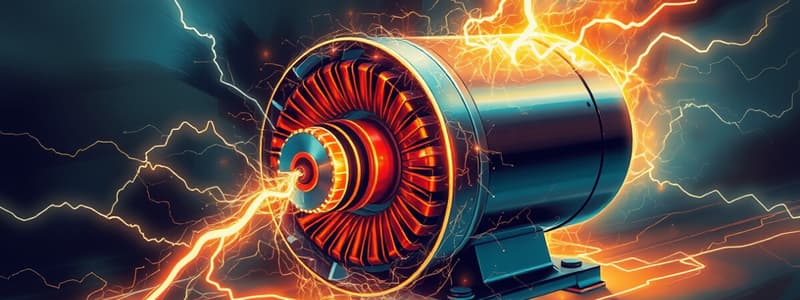Podcast
Questions and Answers
What type of torque is produced when the induction motor starts?
What type of torque is produced when the induction motor starts?
- Breakdown torque
- Synchronous torque
- Starting torque (correct)
- Full-load torque
What happens to slip as the load on an induction motor increases?
What happens to slip as the load on an induction motor increases?
- Slip decreases
- Slip becomes zero
- Slip increases (correct)
- Slip remains constant
Which of the following conditions has a higher current draw in an induction motor?
Which of the following conditions has a higher current draw in an induction motor?
- No-load condition
- Full load condition (correct)
- Light load condition
- Synchronous condition
What is the formula used to calculate slip in an induction motor?
What is the formula used to calculate slip in an induction motor?
At what condition does an induction motor achieve peak efficiency?
At what condition does an induction motor achieve peak efficiency?
How does power factor behave at lower loads in an induction motor?
How does power factor behave at lower loads in an induction motor?
What characterizes the breakdown torque in an induction motor?
What characterizes the breakdown torque in an induction motor?
Which situation can lead to overheating in an induction motor?
Which situation can lead to overheating in an induction motor?
Which of the following describes the relationship between actual speed and synchronous speed in an induction motor?
Which of the following describes the relationship between actual speed and synchronous speed in an induction motor?
What happens to performance when an induction motor operates outside the recommended loading range?
What happens to performance when an induction motor operates outside the recommended loading range?
Flashcards are hidden until you start studying
Study Notes
Induction Motor Load Characteristics
-
Definition: Induction motor load characteristics describe the relationship between motor load (torque) and performance parameters such as speed, current, and efficiency.
-
Torque-Speed Curve:
- Starting Torque: The torque produced when the motor starts; varies with load.
- Breakdown Torque: Maximum torque the motor can deliver; occurs at a specific slip.
- Full-Load Torque: Torque at which the motor is rated for continuous operation.
- Slip: Difference between synchronous speed and actual speed; increases with load.
-
Speed Characteristics:
- Synchronous Speed (Ns): Speed of the magnetic field; determined by supply frequency and number of poles.
- Actual Speed (N): Speed at which the rotor turns; always less than synchronous speed.
- Slip (S): Calculated as ( S = \frac{Ns - N}{Ns} \times 100% ).
-
Current Characteristics:
- No-Load Condition: Low current draw; mainly for overcoming losses (iron and friction).
- Full Load Condition: Higher current draw; proportional to the load and torque.
- Inrush Current: Higher current during startup; reduces after reaching full speed.
-
Efficiency:
- Peaks at a specific load; decreases at very low or high loads.
- Influenced by rotor losses, stator losses, windage, and friction losses.
-
Power Factor:
- Varies with load; usually higher at full load.
- Poor power factor at low loads due to inductive nature of the motor.
-
Load Conditions:
- Light Load: Lower efficiency, higher slip, lower power factor.
- Full Load: Optimal efficiency and power factor.
- Overload: Can lead to overheating and potential damage; motor protection is crucial.
-
Key Observations:
- An induction motor operates efficiently near its rated load.
- Performance deteriorates outside the recommended loading range.
- Regular monitoring of load conditions helps maintain motor health and performance.
Induction Motor Load Characteristics
- Induction motor load characteristics illustrate the relationship between motor load (torque) and performance metrics like speed, current, and efficiency.
Torque-Speed Curve
- Starting Torque: Torque produced at motor startup; varies based on load conditions.
- Breakdown Torque: The maximum torque the motor can deliver; occurs at a specific slip value.
- Full-Load Torque: Defined as the torque at which the motor is rated for continuous use.
- Slip: Represents the difference between synchronous speed and actual speed; slip increases with increasing load.
Speed Characteristics
- Synchronous Speed (Ns): The speed of the magnetic field determined by supply frequency and number of poles.
- Actual Speed (N): The rotor's speed, which is always less than the synchronous speed.
- Slip Calculation (S): Defined by the formula ( S = \frac{Ns - N}{Ns} \times 100% ).
Current Characteristics
- No-Load Condition: Characterized by low current draw primarily inducing losses such as iron and friction.
- Full Load Condition: Higher current draw correlates with load and torque demand.
- Inrush Current: Significantly higher current during startup, which subsides once full speed is achieved.
Efficiency
- Efficiency peaks at a specific load level; it diminishes when operating at either very low or very high loads.
- Efficiency is impacted by rotor losses, stator losses, windage losses, and friction losses.
Power Factor
- The motor's power factor fluctuates with load; it is generally higher during full load conditions.
- A poor power factor is observed at low loads due to the inductive nature of induction motors.
Load Conditions
- Light Load: Associated with lower efficiency, higher slip, and diminished power factor.
- Full Load: Achieves optimal efficiency and power factor.
- Overload: Can cause overheating and damage; therefore, proper motor protection measures are essential.
Key Observations
- Induction motors exhibit optimum efficiency when operating near their rated load.
- Performance tends to deteriorate outside the recommended loading range.
- Regular monitoring of load conditions is crucial for sustaining motor health and performance.
Studying That Suits You
Use AI to generate personalized quizzes and flashcards to suit your learning preferences.




